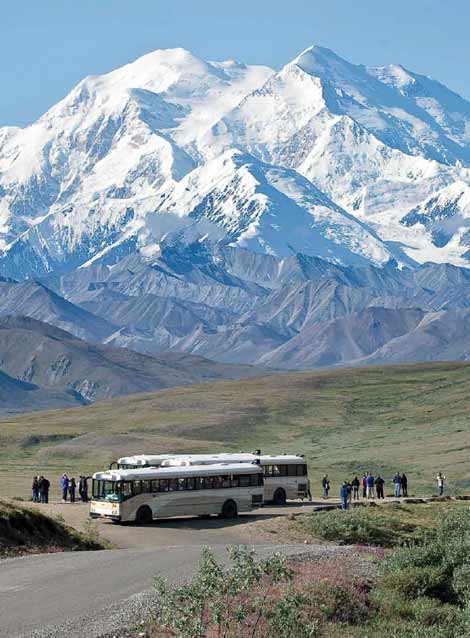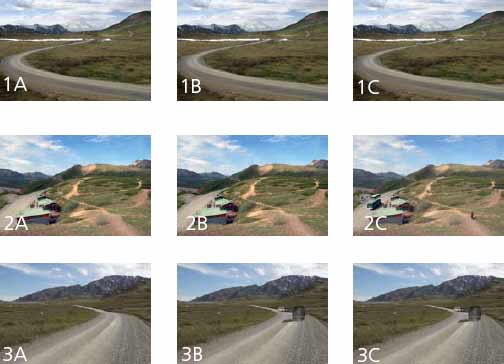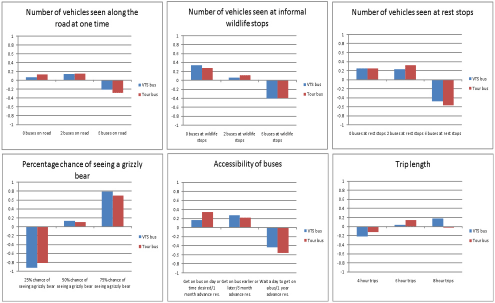Managing the "near-wilderness" experience at Denali
Introduction

NPS Photo
Six-million-acre Denali National Park and Preserve is widely known as a wilderness park. But this vast tract of wild land is bisected by the ninety-mile Denali Park Road, which crosses boreal forests, subarctic tundra, large glacial rivers, and prime wildlife viewing areas.
The road corridor is a mere three hundred feet wide, offering an up close and personal view of wilderness to the hundreds of thousands of visitors each year who travel the road on the park’s innovative Visitor Transportation System (VTS) bus system and commercial tour buses.
This way of experiencing wilderness—it’s been called a “near-wilderness experience”—is increasingly important (Hallo & Manning 2010). At Denali, it provides the vast majority of visitors their primary experience with the park’s wilderness, allowing visitors to observe wildlife in their natural habitat and enjoy outstanding scenery. More broadly, the iconic roads of the national parks such as Going to the Sun Road at Glacier, Tioga Road in Yosemite, and Acadia’s Park Loop Road, along with thousands of miles of other roads that penetrate or skirt many of the country’s wilderness areas, offer “access” to wilderness to the greatest number of “wilderness visitors.” This near-wilderness experience should be managed to help ensure that it is of the highest quality.
Development of a new plan for the Denali Park Road over the past several years has been a good opportunity to explore this type of near-wilderness experience. Initial phases of research to help support this plan identified a number of potential indictors of quality for the Denali Park Road experience (Manning & Hallo 2010). Indicators of quality are measurable, manageable variables that help define the quality of recreation experiences (Manning 2007; Manning 2011). Qualitative and quantitative surveys of visitors, along with other forms of public input, found that potential indicators of quality include: (1) the number of buses seen along the road at any one time; (2) the number of buses seen at informal wildlife stops; (3) the number of buses at rest stops; (4) the percentage chance of seeing a grizzly bear; (5) the accessibility of buses (for example, chance of getting a seat on a bus); and (6) trip length. Respondents and participants reported that all of these indicators were important to the quality of the visitor experience.
But which indicators are most important? This question is especially relevant when some indicator variables may conflict with others. For example, increasing the number of buses on the road would enhance accessibility, but it would also increase the number of buses seen along the road and at rest stops and informal wildlife stops (see figures 2-4 for a range of conditions for these indicator variables). Increasing the number of buses might also reduce the chance of seeing a grizzly bear and other iconic wildlife (though the relationship between these variables is complex). We used a survey and statistical procedure called stated choice analysis to help determine which indicators of quality are most important to visitors.
Study Design
The primary study method was a survey administered to representative samples of bus riders on the Denali Park Road. The study employed stated choice analysis, a procedure that was pioneered in business and marketing applications to evaluate consumer preferences and tradeoffs among product and service attributes (Green et al. 1988; Louviere & Timmermans 1990; Lourviere et al. 2000).
Stated choice analysis has also been used in natural resource and environmental applications (Haider & Ewing 1990; Schroeder et al. 1990; Adamowicz et al. 1994; Boxall et al. 1996) and increasingly in park and wilderness management (Lawson & Manning 2002; Lawson & Manning 2003; Newman et al. 2005; Hunt et al. 2005; Arnberger & Haider 2005; Cahill et al. 2008; Bullock & Lawson 2008; Pettebone et al. 2011; van Riper et al. 2011). The survey was designed so that respondents would be presented with a series of “paired comparisons,” each consisting of two different descriptions of the Denali Park Road experience. Respondents were asked to choose which scenario they preferred for each of the paired comparisons.
The paired comparisons were prepared using a range of potential standards of quality for each of the six indicators of quality noted above. Standards of quality define the minimum acceptable condition of indicators of quality (Manning et al. 2001; Manning 2007; Manning 2011). The resulting matrix (three standards of quality for each of six indicators of quality) is shown in table 1.
As shown in the table, two versions of the survey questionnaire were prepared, one for VTS bus riders and one for tour bus riders. These versions were identical except for the indicators and standards of quality for access to these types of trips; this was due to the very different ways in which visitors access these two types of buses – a first-come, first-served system for VTS buses and a reservation system for tour buses.
The six-by-three matrix results in 729 potential combinations of trip characteristics for each type of bus. Since this is too many combinations to present to respondents, an orthogonal fractional factorial design was used to create thirty-six paired comparisons that were “blocked” into four versions of the questionnaire that were presented to visitors (Louviere et al. 2000; Kuhfeld 2000).
“Blocking” simply means that four versions of the questionnaire were created that included nine paired comparisons for each of the two types of buses; the four versions of the questionnaires each included nine paired comparisons, resulting in visitor responses for all thirty-six paired comparisons. Combinations of photographs and written descriptions of the indicators and standards included in table 1 were used as noted in the table. An example of a paired comparison for VTS bus riders is shown in figure 5.
A systematic sampling protocol was used to select survey respondents and each respondent was asked a screening question to prevent multiple responses from the same visitor. The sampling period was designed to include the park’s peak use period. Sampling was conducted on thirty randomly selected days during July and August. Visitors were approached by a trained survey administrator and asked to complete the questionnaire. At the onset of the survey, the administrator gave instructions about how to complete the questionnaire, made sure that the respondent understood the instructions, and provided assistance with posters that presented the paired comparison scenarios. Response rates of 91 percent and 56 percent were achieved for VTS bus riders and tour bus riders, respectively. This yielded 392 completed VTS questionnaires and 398 tour bus questionnaires. A total of 3,528 choice comparisons were made by survey respondents who rode on VTS buses and 3,573 choice comparisons were made by survey respondents who rode on tour buses.

Figure 2. Visual simulations for the range of conditions presented for the “buses seen along roads” indicator variable, with zero, two, and six buses seen along the road.

Figure 3. Visual simulations for the range of conditions presented for the “buses seen at rest stops” indicator variable, with zero, two, and six buses (and zero, 36, and 108 people, respectively) seen at rest stops.

Figure 4. Visual simulations for the range of conditions presented for the “informal wildlife stops” indicator variable, with zero, two, and six buses at these informal stops.
Data Analysis
Data analysis was conducted in two phases. First, a multinomial logit (MNL) model was constructed with data from respondents who rode on the (1) VTS buses and (2) tour buses. The second phase of data analysis consisted of determining the relative importance of each of the indicators of quality by using a Log-likelihood Ratio (LLR) test. The LLR chi square values were used to rank the indicators, assuming that the coefficients with larger chi square values had a greater influence on the overall fit of the model (Holmes & Adamowicz 2003).
Study Findings
Results from the first phase of data analysis are shown graphically in figure 6. The bar graphs in the figure show the “utility” for the standards of quality presented for each indicator variable (Holmes & Adamowicz 2003). Utility values may range from -1 (strongly not preferred) to +1 (strongly preferred). In general, VTS bus riders preferred seeing fewer vehicles along the park road, at wildlife stops, and at rest areas; having a greater chance to see grizzly bears; having the highest level of access to the buses they wish to be on; and longer trip lengths. Results from tour bus riders were quite similar to those of VTS bus riders with the exception that tour bus riders prefer an intermediate length trip.
Results from the second phase of the analysis are presented in table 2. This phase of analysis examines the relative importance of each of the six indicators of quality. This was done by comparing data from the MNL models for VTS and tour bus rides using the LLR test. The resulting chi square values were used to rank the importance of each of the six indicators of quality. The order of ranked importance for each of the indicators for both the VTS and tour bus riders were very similar. The percent chance of seeing a grizzly bear was by far the most important indicator, with the number of visitors seen at rest stops being the second most important. Bus accessibility and the number of buses seen at wildlife stops were the third and fourth most important indicators, respectively. For VTS respondents, trip length was the fifth most important indicator while the number of buses seen on the road was the least important indicator. The order of importance for these last two indicators was reversed for tour bus respondents.

Table 1. Stated choice matrix for VTS and tour bus riders, with indicators and standards of quality for the stated choice questions.
| Indicators | VTS Bus Standards | Tour Bus Standards |
|---|---|---|
| 1. Number of vehicles seen along the road at one time | 1. Photo with 0 buses 2. Photo with 2 buses 3. Photo with 6 buses | 1. Photo with 0 buses 2. Photo with 2 buses Photo with 6 buses |
| 2. Number of vehicles seen at informal wildlife stops | 1. Photo with 0 buses 2. Photo with 2 buses 3. Photo with 6 buses | 1. Photo with 0 buses 2. Photo with 2 buses 3. Photo with 6 buses |
| 3. Number of vehicles seen at rest stops | 1. Photo with 0 buses 2. Photo with 2 buses 3. Photo with 6 buses | 1. Photo with 0 buses 2. Photo with 2 buses 3. Photo with 6 buses |
| 4. Percent chance of seeing a grizzly bear | 1. 25% 2. 50% 3. 75% | 1. 25% 2. 50% 3. 75% |
| 5. Accessibility of buses | 1. Most visitors would be able to get on a bus on the day and time they prefer. 2. Many visitors would have to get on a bus earlier or later in the day than they prefer. 3. Many visitors would have to wait a day to get on a bus | 1. You would need to make a reservation for a bus trip about a month in advance. 2. You would need to make a reservation for a bus trip about 6 months in advance. 3. You would need to make a reservation for a bus trip about a year in advance. |
| 6. Trip length | 1. Bus trips would average about 4 hours 2. Bus trips would average about 6 hours 3. Bus trips would average 8 hours or more | 1. Bus trips would average about 4 hours 2. Bus trips would average about 6 hours 3. Bus trips would average 8 hours or more |
Conclusions

Findings from this study have helped inform development of the recent Denali Park Road Vehicle Management Plan (National Park Service 2012).
It’s clear that the ability to see grizzly bears (and other iconic wildlife) is the most important indicator of quality for the near-wilderness experience on the Denali Park Road, and the new plan will monitor wildlife and wildlife sightings and consider adjusting elements of road and vehicle management if bus and other traffic on the road are found to be impacting wildlife, with special attention to grizzly bears and Dall sheep. The number of buses seen along the road is also important to visitors, especially at rest and informal wildlife stops, and the new plan limits road use to a maximum of one hundred sixty vehicles per twenty-four-hour period to help maintain a reasonable sense of “solitude” as defined by near-wilderness visitors.
Visitors are also concerned about maintaining reasonable access to both VTS and tour buses and the new plan provides that a majority of seats on both types of buses will be available by reservation, thus helping to ensure access to those who plan ahead. Trip length was more important to VTS bus riders than tour bus riders and VTS bus riders prefer a longer trip than tour bus riders. In the new vehicle management plan, VTS riders have options for long trips while tour buses are limited to shorter trips.
This study was part of an interdisciplinary program of research conducted to help inform development of the recent Denali Park Road Vehicle Management Plan (Phillips et al. 2010; Manning & Hallo 2010; Morris et al. 2010). The program of research included visitor surveys, wildlife tracking, and simulation modeling of vehicle use patterns.
Based on this program of research, other information, and public input, the new plan includes a series of indicators and standards of quality for the near-wilderness experience, a commitment to monitoring these indicators of quality, and a program of adaptive management to ensure that standards of quality are maintained.
Part of a series of articles titled Alaska Park Science - Volume 13 Issue 1: Wilderness in Alaska.
Last updated: February 5, 2015
